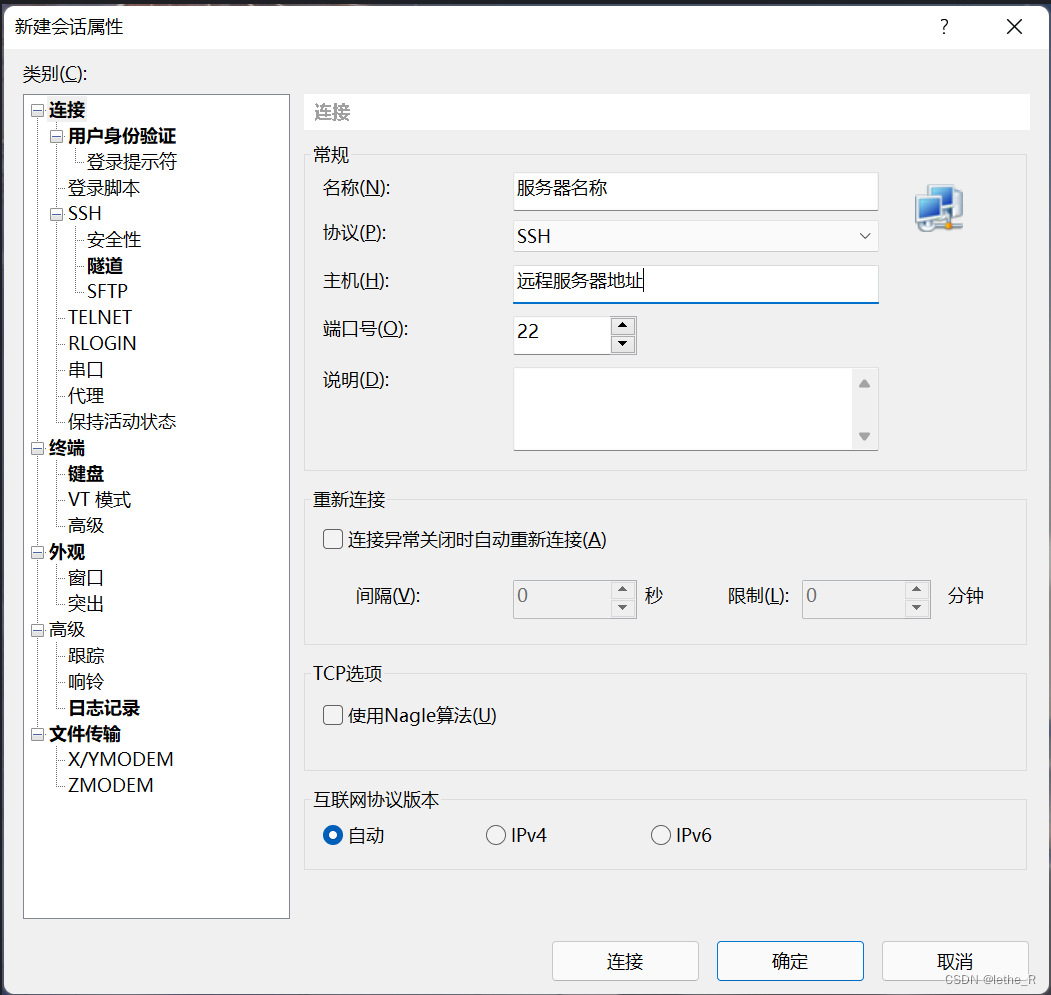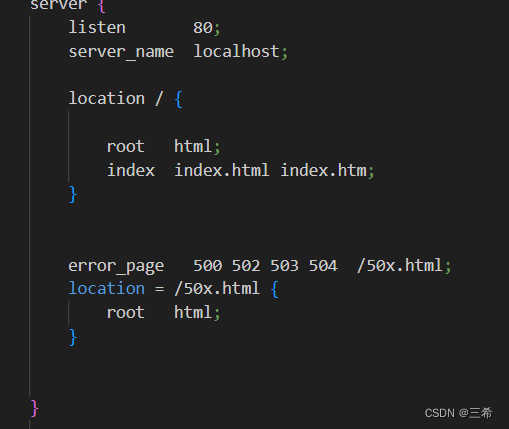我们在会开发项目的同时,也应该了解一下前端是如何部署项目的;
一、准备环境
1、服务器或者虚拟机(后端已经搭建好的,这里就不讲述如何搭建服务器了)
2、Xshell 和 Xftp --> 存放静态文件和操作服务器
3、Windows系统
Xshell:是一个强大的安全终端模拟软件,可以在Windows界面下用来访问远端不同系统下的服务器。(作用就是用来连接远程服务器的)
Xftp:是一个功能强大的SFTP、FTP 文件传输软件。(作用是存放静态文件和上传静态资源)
二、安装Nginx
使用Xshell连接服务器,既然想要在服务器上面放静态资源,像HTML,js等,就需要安装静态资源服务器。静态资源服务器有Apache和Nginx,这里我们选用nginx。
1、 安装Nginx依赖
yum install -y pcre pcre-devel
yum install -y zlib zlib-devel
yum install gcc-c++
yum install -y openssl openssl-devel
2、下载Nginx
wget -c https://nginx.org/download/nginx-0.1.18.tar.gz
3、解压下载好的Nginx 压缩包
tar -zxvf nginx-0.1.18.tar.gz
cd nginx-0.1.18
4、编译安装Nginx
./configure --with-http_ssl_module
make
make install
5、启动Nginx服务
whereis nginx
启动服务:
/usr/local/nginx/sbin/nginx
./nginx
三、操作步骤
1、使用Xshell连接服务器
输入服务器名称、地址、端口号,连接成功后会让你输入账号和密码,账号一般是默认的root。

在Xshell中启动Nginx:
1、查找安装的路径:whereis nginx;
2、执行Nginx启动命令:/usr/local/nginx/sbin/nginx;
3、查看服务运行状态:ps -ef | grep nginx;
4、停止服务:kill 进程号; /usr/local/nginx/sbin/nginx -stop
5、重启服务:/usr/local/nginx/sbin/nginx -s reopen
2、上传静态资源文件
连接Xftp,进行文件传输。服务器的根目录是 /root ,这里可以创建一个自己的项目文件目录进行静态资源文件的存放。直接把打包后的dist文件放在目标目录即可。
3、 配置Nginx
配置命令:vim /usr/local/nginx/conf/nginx.conf(vim + nginx目录)
#全局块 :配置影响nginx全局的指令。一般有运行nginx服务器的用户组,nginx进程pid存放路径,日志存放路径,配置文件引入,允许生成worker process数等。
#user nobody/root; #配置用户或者组,默认为nobody root
user root;
worker_processes 1; #允许生成的进程数,默认是1
#error_log logs/error.log;
#error_log logs/error.log notice;
#error_log logs/error.log info;
#pid logs/nginx.pid; #指定nginx进程运行文件存放地址
events { #event块:配置影响nginx服务器或与用户的网络连接。有每个进程的最大连接数,选取哪种事件驱动模型处理连接请求,是否允许同时接受多个网路连接,开启多个网络连接序列化等。
accept_mutex on; #设置网路连接序列化,防止惊群现象发生,默认为on
multi_accept on; #设置一个进程是否同时接受多个网络连接,默认为off
#use epoll; #事件驱动模型,select|poll|kqueue|epoll|resig|/dev/poll|eventport
worker_connections 1024; #最大连接数,默认为512
}
http { #http块:可以嵌套多个server,配置代理,缓存,日志定义等绝大多数功能和第三方模块的配置。如文件引入,mime-type定义,日志自定义,是否使用sendfile传输文件,连接超时时间,单连接请求数等。
include mime.types; #文件扩展名与文件类型映射表
default_type application/octet-stream; #默认文件类型,默认为text/plain、octet-stream未知文件类型
#log_format main '$remote_addr - $remote_user [$time_local] "$request" '
# '$status $body_bytes_sent "$http_referer" '
# '"$http_user_agent" "$http_x_forwarded_for"';
#access_log logs/access.log main;
sendfile on; #开启高效文件传输模式
#tcp_nopush on;
#keepalive_timeout 0;
keepalive_timeout 65;#保持请求活跃时间
#gzip on;
#error_page 404 https://www.baidu.com; #错误页
#http全局块
server { #server块:配置虚拟主机的相关参数,一个http中可以有多个server。
keepalive_requests 120; #单连接请求上限次数。
listen 80; #监听端口
server_name 127.0.0.1;#监听地址-->设置对应监听的域名xxx.com www.baidu.com
#charset koi8-r;
#access_log logs/host.access.log main;
#请求的url过滤,正则匹配,~为区分大小写,~*为不区分大小写。
location / { #location块:配置请求的路由,以及各种页面的处理情况。
#root path; #根目录
#index vv.txt; #设置默认页
root html;
index index.html index.htm;
#proxy_pass http://mysvr; #请求转向mysvr 定义的服务器列表-->可以填写自己的服务器地址
#proxy_read_timeout 150; 代理连接超时时间
#deny 127.0.0.1; #拒绝的ip
#allow 172.18.5.54; #允许的ip
}
#error_page 404 /404.html;
# redirect server error pages to the static page /50x.html
#
error_page 500 502 503 504 /50x.html;
location = /50x.html {
root html;
}
# proxy the PHP scripts to Apache listening on 127.0.0.1:80
#
#location ~ .php$ {
# proxy_pass http://127.0.0.1;
#}
# pass the PHP scripts to FastCGI server listening on 127.0.0.1:9000
#
#location ~ .php$ {
# root html;
# fastcgi_pass 127.0.0.1:9000;
# fastcgi_index index.php;
# fastcgi_param SCRIPT_FILENAME /scripts$fastcgi_script_name;
# include fastcgi_params;
#}
# deny access to .htaccess files, if Apache's document root
# concurs with nginx's one
#
#location ~ /.ht {
# deny all;
#}
}
# another virtual host using mix of IP-, name-, and port-based configuration
#
#server {
# listen 8000;
# listen somename:8080;
# server_name somename alias another.alias;
# location / {
# root html;
# index index.html index.htm;
# }
#}
# HTTPS server
#
#server {
# listen 443 ssl;
# server_name localhost;
# ssl_certificate cert.pem;
# ssl_certificate_key cert.key;
# ssl_session_cache shared:SSL:1m;
# ssl_session_timeout 5m;
# ssl_ciphers HIGH:!aNULL:!MD5;
# ssl_prefer_server_ciphers on;
# location / {
# root html;
# index index.html index.htm;
# }
#}
# 测试配置
server {
listen 8777;
server_name http://127.0.0.1/;
gzip on; # 开启Gzip
# gzip_static on; # 开启静态文件压缩 这句话不要
gzip_min_length 1k; # 不压缩临界值,大于1K的才压缩
gzip_buffers 4 16k;
gzip_comp_level 5;
gzip_types application/javascript application/x-javascript application/xml application/xml+rss application/x-httpd-php text/plain text/javascript text/css image/jpeg image/gif image/png; # 进行压缩的文件类型
gzip_http_version 1.1;
gzip_vary on;
gzip_proxied expired no-cache no-store private auth;
gzip_disable "MSIE [1-6].";
location / {
root /home/myProject/dist; # root表示根目录,这里的路径需要与Xftp上传的静态资源文件的路径一致
index index.html index.htm;
try_files $uri $uri/ /index.html;
}
location @router {
rewrite ^.*$ /index.html last;
}
}
}
4、 重启Nginx服务
重启命令:/usr/local/nginx/sbin/nginx -s reopen
最后在浏览器中输入:http://127.0.0.1:8777/即可访问部署成功的项目;

原文地址:https://blog.csdn.net/qq_45787691/article/details/127765857
本文来自互联网用户投稿,该文观点仅代表作者本人,不代表本站立场。本站仅提供信息存储空间服务,不拥有所有权,不承担相关法律责任。
如若转载,请注明出处:http://www.7code.cn/show_26706.html
如若内容造成侵权/违法违规/事实不符,请联系代码007邮箱:suwngjj01@126.com进行投诉反馈,一经查实,立即删除!
主题授权提示:请在后台主题设置-主题授权-激活主题的正版授权,授权购买:RiTheme官网
声明:本站所有文章,如无特殊说明或标注,均为本站原创发布。任何个人或组织,在未征得本站同意时,禁止复制、盗用、采集、发布本站内容到任何网站、书籍等各类媒体平台。如若本站内容侵犯了原著者的合法权益,可联系我们进行处理。








